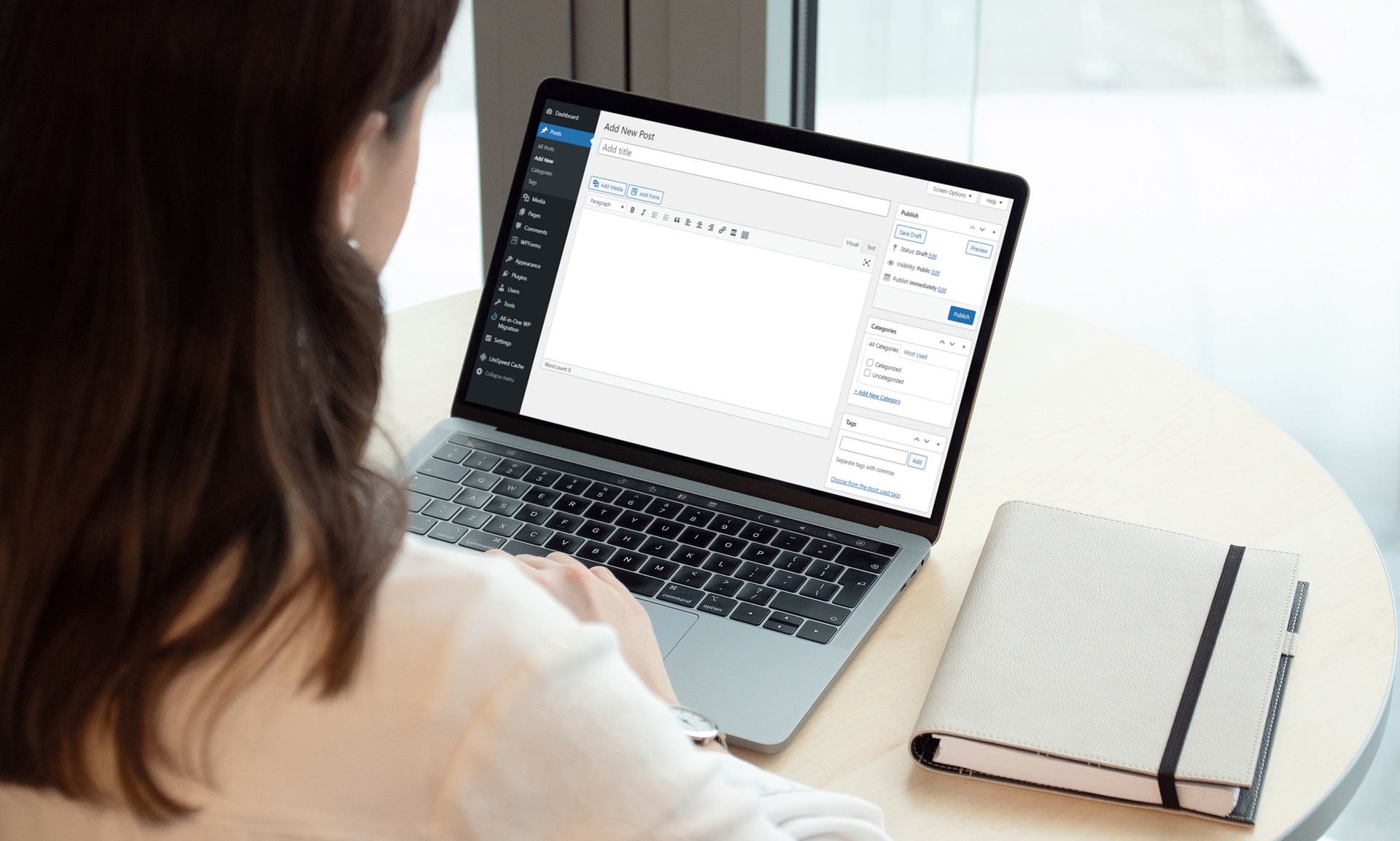Setting up a blog on WordPress can seem like a daunting task, especially for beginners. However, with the right guidance, the process of how to set up a blog on WordPress can be relatively straightforward and rewarding. This step-by-step guide aims to demystify the process and help you launch your WordPress blog with confidence. Whether you’re a seasoned blogger looking to transition to a more versatile platform or a complete novice taking your first steps into the world of blogging, this guide will equip you with the necessary knowledge and tools for a successful WordPress blog setup.
Table of Contents
ToggleUnderstanding the Basics: Creating a WordPress Blog
To begin, familiarize yourself with the key elements of creating a WordPress blog. First, you’ll need to secure a domain name and web hosting service. Several reputable hosting providers, such as Bluehost and SiteGround, offer one-click WordPress installations, streamlining the initial setup process. Once you’ve chosen a domain name and hosting service, installing WordPress becomes a seamless task, enabling you to access the versatile features and customizable options that WordPress offers for your blog.
Navigating the Setup Process: Essential WordPress Blogging Tips
Upon installing WordPress, you’ll be greeted with a user-friendly interface that allows you to customize your blog’s appearance and functionality as you learn how to set up a blog on WordPress. Explore the diverse range of WordPress themes and select one that aligns with your blog’s niche and overall aesthetic. Additionally, consider installing essential plugins, such as Yoast SEO and Akismet, to optimize your blog for search engines and protect it from spam. These plugins can significantly enhance your blog’s performance and security, providing a seamless and engaging user experience for your audience.
Crafting Compelling Content: Maximizing Your WordPress Blog's Potential
With your blog’s framework in place, focus on creating high-quality, engaging content that resonates with your target audience. Utilize WordPress’s intuitive content management system to draft and publish blog posts effortlessly. Leverage multimedia elements, such as images, videos, and infographics, to enhance the visual appeal of your content and make it more shareable across various social media platforms. Remember to incorporate relevant keywords naturally throughout your posts to improve your blog’s visibility and search engine ranking.
Optimizing for Success: WordPress Blogging Best Practices
Optimizing your WordPress blog for success in how to set up a blog on WordPress involves implementing effective SEO strategies and regularly updating your content to keep it relevant and valuable to your readers. Familiarize yourself with on-page and off-page SEO techniques to drive organic traffic to your blog and increase its online visibility. Furthermore, establish a consistent posting schedule to maintain reader engagement and foster a loyal community around your blog. Encourage user interaction by enabling comments and responding to your audience’s feedback promptly.
Continual Growth and Development: Evolving Your WordPress Blog
As your WordPress blog gains momentum, monitor its performance using analytics tools such as Google Analytics to track key metrics like website traffic, user engagement, and conversion rates. Analyze the data to identify areas for improvement and capitalize on successful strategies to expand your blog’s reach and influence. Continuously educate yourself about the latest trends and developments in the blogging sphere to stay ahead of the curve and adapt your content strategy accordingly. Embrace experimentation and innovation to keep your WordPress blog dynamic and engaging for your readers.
Ensuring Security and Reliability: Protecting Your WordPress Blog
While setting up your WordPress blog and understanding how to set up a blog on WordPress, prioritizing security measures is crucial to safeguarding your content and data. Implement robust security plugins like Wordfence or Sucuri to fortify your blog against potential cyber threats and hacking attempts. Regularly update WordPress core files, themes, and plugins to ensure that your blog remains equipped with the latest security patches and enhancements. Additionally, create strong, unique passwords and enable two-factor authentication to add an extra layer of protection to your WordPress account.
Engaging with the WordPress Community: Networking and Support
One of the key advantages of using WordPress is the vibrant and supportive community that surrounds it. Engage with fellow bloggers and WordPress enthusiasts through forums, social media groups, and local meetups to exchange insights, tips, and best practices. Seek guidance from experienced members of the community to troubleshoot any technical issues or challenges you encounter during the blog setup process. Contributing to the community by sharing your knowledge and experiences can foster meaningful connections and collaborations that enhance your blogging journey.
Mobile Optimization: Ensuring Seamless Accessibility for How to Set Up a Blog on WordPress
Given the increasing prevalence of mobile browsing and the importance of how to set up a blog on WordPress, optimizing your WordPress blog for mobile devices is paramount. Choose a responsive WordPress theme that automatically adjusts the layout and design of your blog to suit various screen sizes and resolutions. Test your blog’s mobile responsiveness regularly to ensure a seamless and user-friendly experience for visitors accessing your content on smartphones and tablets. Prioritize fast loading times and intuitive navigation to minimize bounce rates and maximize user engagement across all devices.
Monetization Strategies: Generating Revenue from Your WordPress Blog
Once you’ve established a solid foundation for your WordPress blog, explore various monetization strategies to generate revenue and potentially turn your passion for blogging into a sustainable income stream. Consider incorporating display advertising, affiliate marketing, sponsored content, or selling digital products and services relevant to your niche. Conduct thorough market research and align your monetization approach with your audience’s preferences and needs to optimize your blog’s earning potential while maintaining its authenticity and credibility. Continuously assess and refine your monetization strategies to adapt to evolving market trends and maximize your blog’s profitability.
Regular Maintenance: Ensuring Long-Term Blog Viability
To sustain the success of your WordPress blog, prioritize regular maintenance tasks to uphold its performance and functionality. Routinely update plugins, themes, and WordPress versions to leverage the latest features and security enhancements. Conduct thorough backups of your blog’s content and data to mitigate the risks associated with potential technical glitches or data loss. Monitor your blog’s loading speed and optimize its performance by minimizing unnecessary plugins, compressing images, and employing caching mechanisms to deliver a seamless browsing experience for your audience.
Utilizing Analytics for Informed Decision-Making: Data-Driven Insights
Harness the power of analytical tools to gain valuable insights into how to set up a blog on WordPress, your WordPress blog’s performance, and user behavior. Leverage data-driven metrics to identify popular content, user engagement patterns, and conversion rates. Use this information to refine your content strategy, tailor your offerings to your audience’s preferences, and optimize your blog for an enhanced user experience and increased engagement. Implement A/B testing to experiment with different layouts, headlines, and calls-to-action, and use the results to make informed decisions that drive continual growth and improvement.
Enhancing User Experience: Implementing Interactive Elements
Elevate your WordPress blog’s user experience by incorporating interactive elements that encourage visitor engagement and participation. Integrate social sharing buttons to facilitate seamless content sharing across various social media platforms and broaden your blog’s reach. Incorporate polls, surveys, and quizzes to solicit feedback from your audience and foster a sense of community involvement. Encourage user-generated content, such as guest posts or comments, to stimulate meaningful discussions and establish a lively, interactive online community centered around your blog’s niche.
Given the dynamic nature of the digital landscape, staying updated with the latest WordPress trends and innovations is essential to remain competitive and relevant. Regularly explore WordPress blogs, forums, and industry publications to stay informed about emerging plugins, design trends, and best practices that can enhance your blog’s performance and aesthetics. Attend webinars, workshops, and online courses to expand your knowledge and skills, and apply newfound insights to elevate your blog’s overall quality and appeal.
Creating a Brand Identity: Establishing a Unique Voice
Differentiate your WordPress blog by cultivating a distinct brand identity that reflects how to set up a blog on WordPress, your values, mission, and unique voice. Craft a compelling About Me page that introduces yourself to your audience and communicates your passion and expertise within your chosen niche. Develop a consistent tone and style for your content that resonates with your target demographic and reinforces your brand’s personality and message. Incorporate a visually appealing logo, color scheme, and typography that align with your brand’s identity and create a memorable, cohesive visual identity across your blog and associated social media channels.
Promoting Your Blog: Strategic Marketing Initiatives
To expand your blog’s reach and attract a wider audience, implement strategic marketing initiatives that leverage various online channels and platforms. Develop a comprehensive content marketing strategy that encompasses SEO optimization, social media promotion, email newsletters, and guest blogging to amplify your blog’s visibility and establish thought leadership within your niche. Collaborate with influencers and industry experts to expand your network and tap into their established audiences. Engage in strategic partnerships and cross-promotional activities to increase your blog’s exposure and foster mutually beneficial relationships within your industry.
Ensuring Accessibility and Inclusivity: User-Friendly Design Practices
Prioritize accessibility and inclusivity in how to set up a blog on WordPress, your WordPress blog’s design to cater to a diverse audience, including individuals with disabilities. Implement user-friendly design practices such as using descriptive alt text for images, ensuring proper color contrast for text visibility, and incorporating screen reader compatibility for visually impaired users. Adhere to web accessibility standards outlined by the Web Content Accessibility Guidelines (WCAG) to ensure that all visitors can navigate and consume your content seamlessly, fostering an inclusive and welcoming online environment for all users.
Building a Community: Cultivating Reader Engagement
Foster a sense of community and connection among your readers by actively encouraging interaction and dialogue on how to set up a blog on WordPress your WordPress blog. Prompt discussions by posing thought-provoking questions, inviting feedback, and responding to comments and inquiries in a timely and genuine manner. Establish a dedicated space, such as a forum or private membership area, where like-minded individuals can connect, share insights, and support one another. Organize virtual events, such as webinars or live Q&A sessions, to foster real-time engagement and nurture meaningful relationships within your blog’s community.
Implementing Effective Email Marketing Strategies: Cultivating Subscriber Relationships
Harness the power of email marketing to cultivate and nurture relationships with your blog’s subscribers. Develop a comprehensive email marketing strategy that includes personalized newsletters, exclusive content offerings, and promotional updates to keep your subscribers engaged and informed about your latest blog posts and offerings. Segment your email list based on subscribers’ preferences and behavior to deliver targeted and relevant content that resonates with their interests and needs. Utilize compelling call-to-action buttons and visually appealing email templates to encourage subscribers to take specific actions and deepen their engagement with your blog’s content and offerings.
Legal Compliance and Privacy Measures: Protecting User Data
Adhere to legal regulations and privacy standards to safeguard your WordPress blog and protect your users’ sensitive information on how to set up a blog on WordPress. Familiarize yourself with data protection laws such as the General Data Protection Regulation (GDPR) and implement necessary measures to secure and manage user data responsibly. Display a transparent privacy policy that outlines how you collect, use, and store user data, and provide users with the option to opt in or out of data collection and marketing communications. Regularly audit your blog’s compliance with legal requirements and make necessary adjustments to maintain transparency and trust with your audience.
Expanding Your Reach: Leveraging Social Media Platforms
Utilize various social media platforms to amplify the reach and visibility of your WordPress blog. Create engaging and shareable content tailored to each platform’s unique features and audience demographics. Establish a consistent social media posting schedule to maintain an active online presence and foster meaningful interactions with your followers. Encourage social sharing by integrating social media buttons into your blog posts and actively participating in relevant online communities and discussions.
Leverage social media advertising and sponsored posts to target specific audience segments and drive traffic to your WordPress blog, expanding your online reach and fostering a loyal following across diverse digital channels.
Embracing Multimedia Content: Diversifying Your Blog's Offerings
Diversify your WordPress blog’s content by incorporating multimedia elements that appeal to various learning styles and preferences in how to set up a blog on WordPress. Experiment with video tutorials, podcasts, and live streaming sessions to deliver dynamic and engaging content that complements your written blog posts. Leverage visual storytelling techniques through captivating imagery, interactive graphics, and animated visuals to convey complex information and evoke an emotional connection with your audience. Adopt a multimedia content strategy that caters to the diverse preferences of your readers and enhances their overall browsing experience on your WordPress blog.
Optimizing for Local SEO: Targeting Regional Audiences
If your WordPress blog caters to a specific geographical area, prioritize local search engine optimization (SEO) strategies to enhance your blog’s visibility within your target region. Claim and optimize your Google My Business listing to ensure that your blog appears prominently in local search results and maps. Incorporate location-specific keywords and phrases naturally throughout your content to signal relevance to local search queries. Encourage customer reviews and testimonials to build trust and credibility within your local community, and foster partnerships with other local businesses and organizations to expand your blog’s local network and customer base.
Diversifying Revenue Streams: Exploring E-commerce Opportunities
Explore e-commerce opportunities to diversify your WordPress blog’s revenue streams and capitalize on how to set up a blog on WordPress, your audience’s purchasing intent. Set up an online store using WordPress-compatible e-commerce plugins like WooCommerce to sell digital or physical products directly to your audience. Offer exclusive merchandise, e-books, courses, or personalized services that align with your blog’s niche and cater to your readers’ specific needs and interests. Implement secure payment gateways and user-friendly navigation to streamline the purchasing process and cultivate a seamless online shopping experience that encourages repeat business and fosters customer loyalty.
Emphasizing Content Quality: Prioritizing Value Over Quantity
Prioritize the quality and value of your WordPress blog’s content over its quantity. Focus on creating in-depth, well-researched, and insightful articles that address your audience’s pain points and provide actionable solutions. Craft compelling storytelling narratives that resonate with your readers on a personal level and evoke emotional engagement. Conduct regular content audits to assess the performance and relevance of your existing blog posts, and update or repurpose outdated content to ensure its continued value and relevance. Strive for authenticity, originality, and authenticity in your content to establish your WordPress blog as a credible and trusted source of information within your niche.
Cultivating Long-Term Relationships: Engaging with Loyal Readers
Nurture long-term relationships with your loyal readers by fostering a sense of community and personal connection in how to set up a blog on WordPress. Respond to comments and emails promptly, addressing any inquiries or feedback with genuine care and consideration. Acknowledge and appreciate your readers’ contributions and support through shout-outs, mentions, or special features that highlight their engagement and involvement with your blog. Create exclusive membership programs or subscriber-only content to reward and incentivize your most dedicated readers, fostering a sense of exclusivity and belonging within your blog’s community.
Embracing Continuous Innovation: Evolving with Technology
Embrace a mindset of continuous innovation and adaptation to stay ahead of technological advancements and evolving digital trends. Keep abreast of emerging technologies and tools that can enhance your WordPress blog’s functionality and user experience, such as artificial intelligence (AI) chatbots, voice search optimization, or virtual reality (VR) integrations. Experiment with new content formats, interactive features, and immersive storytelling techniques that leverage cutting-edge technologies to captivate and engage your audience in novel and compelling ways.
Building Trust and Credibility: Establishing Expertise and Authority
Build trust and credibility within your niche by positioning yourself as an authoritative and knowledgeable voice in your field and understanding how to set up a blog on WordPress. Create comprehensive, well-researched cornerstone content that serves as a go-to resource for industry-related topics and frequently asked questions. Share your expertise through guest speaking opportunities, guest blogging, or participation in industry events and conferences to showcase your thought leadership and establish your presence as a respected influencer within your niche. Cultivate genuine relationships with fellow industry experts and influencers, collaborating on joint projects and initiatives that reinforce your credibility and expand your network within your field.
Crisis Management and Preparedness: Mitigating Potential Challenges
Develop a comprehensive crisis management plan to address and mitigate potential challenges or setbacks that may arise during your WordPress blogging journey. Anticipate and prepare for scenarios such as website crashes, security breaches, negative feedback, or content controversies by establishing clear protocols and communication strategies to address issues swiftly and effectively. Maintain transparent and honest communication with your audience during challenging times, demonstrating accountability and a commitment to resolving any issues with integrity and professionalism. Invest in reliable backup systems and security measures to protect your blog’s data and content, ensuring that your blogging endeavors remain resilient and sustainable in the face of adversity.
Conclusion: Empowering Your Journey as a WordPress Blogger
In conclusion, setting up a successful blog on WordPress and understanding how to set up a blog on WordPress requires a combination of technical know-how, creative ingenuity, and a genuine passion for engaging with your audience. By following this comprehensive step-by-step guide, you can navigate the intricate process of creating and maintaining a WordPress blog with confidence and finesse. Embrace the journey as a continuous learning experience, staying adaptable to the evolving digital landscape and harnessing innovative strategies to elevate your blog’s visibility, credibility, and engagement. Cultivate a supportive network within the WordPress community, prioritize user experience and inclusivity, and remain dedicated to delivering valuable, authentic content that resonates with your readers.
With perseverance, dedication, and a commitment to excellence, your WordPress blog has the potential to become a dynamic and influential platform that not only amplifies your voice but also cultivates meaningful connections and impact within your chosen niche.











